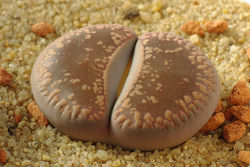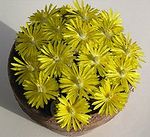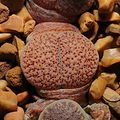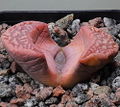Living stones
| Living stones |
|---|

|
| Scientific Classification |
|
| Species |
|
There are a lot of extremely strange plants in the world. However, there is a plant that can camouflages itself by looking identical to a stone. They are called lithops. They are very easy to grow and don't need much care so they are very popular house plant. Their flowers look beautiful and since they are small, many number of them can fit into even a small pot so when they all bloom. [3]
Body Design
Lithops normally live in the dry area of Southern Africa. Since less than 2 inches of rain falls throughout the year, their body is only formed with two thick leaves to save as much water they can. When we think of plants, we normally think that they have leaf, stem and a root. However, lithops doesn't have a stem but their root is attached to the leaves. The reason for that is also to save water. That way, they are able to live a few months without water. Also, lithops are normally very small, about only few centimeters long and hard to see. It's because they keep themselves a low profile not to get too much heat and sunlight. [4]
Life Cycle
Lithops are perennial plants. Every year, it grows a new pair of leaves under the old leaves. After the flowers come out in the fall, it prepares for winter. One interesting thing is that the plant shouldn't be watered during that time to make the old leaves dry out and allow the new leaves to consume the old leaves and grow successfully. After it grows, there will be a new flower next fall but depending on the species, the color can be white, pink and even orange but usually they are yellow. After pollination with two flowers, a seed capsule is kept between the leaves. Then when there is rain, the seed capsule opens and lets the seed out. It closes when it is dry and can wait for years to germinate but once it begins to germinate, it takes about 2 to 7 days. Because they are from the desert, they produce hundreds of seeds but only a few number survive. [5]
Ecology
Unlike most of the plants we see and hear, lithops have two extremely different aspects that make them different. For most of plants, pollination is done by insects like bees and moths. Lithops are no different, but their pollination only happens during afternoon and early evening. The reason is because of their nature to save water, their flowers hide at night. They can also become semi-subterranean, which means they can hide half of them in the dirt. At those times, the plant it self pulls itself into the soil and endures the harsh conditions of the desert and lose as little water they can.[6]
Cultivation
Lithops are not a plant you can see every day and it is also from the desert. Therefore, you need extra care when you want to have a lithops in your home. The most important thing for a lithop is water. They have a very long root compared to their leaves. Therefore, you need a small but somewhat long pot than when you are growing other plants. Also, they should not be exposed to sunlight for a long time or they will die. It is best for them to be facing west. When lithops shed, they are growing. You should take extra care of them during this time. While watering, it is wisest to only dampen the soil halfway.[7]
Video
It is a video about the growth of a lithop
Gallery
References
- ↑ Classification for Kingdom Plantae Down to Family Aizoaceae USDA Plants Database. Web. Accessed May 18, 2015.
- ↑ Lithops Wikispecies. Web. Last updated April 2, 2014.
- ↑ 행복한일상. 리톱스 키우기-리톱스 성장일기2 Naver Blog. Web. Updated May 31, 2014.
- ↑ Rowlette, Nick. A guide to the cultivation of Lithops Lithops. Web. Accessed May 16, 2015.
- ↑ Petra. Lithops-Infos Blog of a plant-whisperer. Web. Accessed May 24, 2015.
- ↑ Oliver, Ian. Lithops Lithops N.E.Br. . Web. published. July, 2005
- ↑ 리톱스 관리하기-1 Naver Blog. Web. Updated. August 24, 2008






